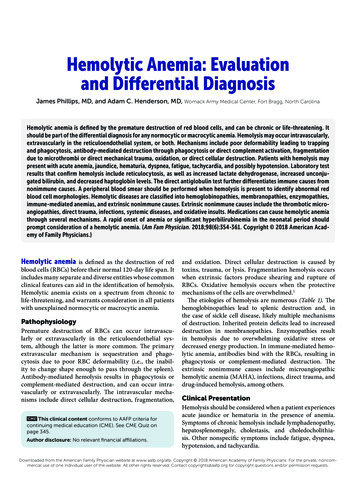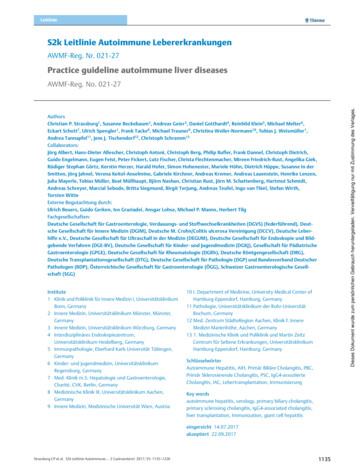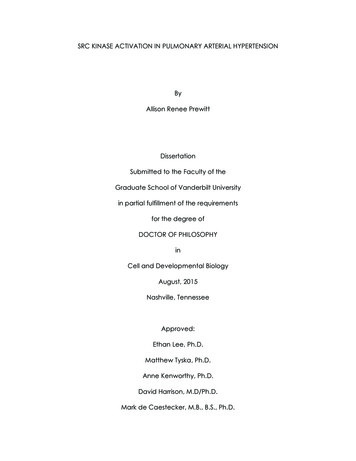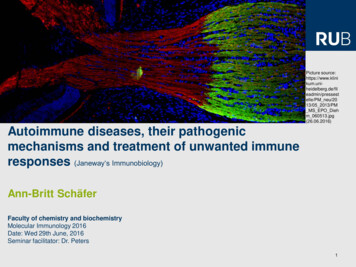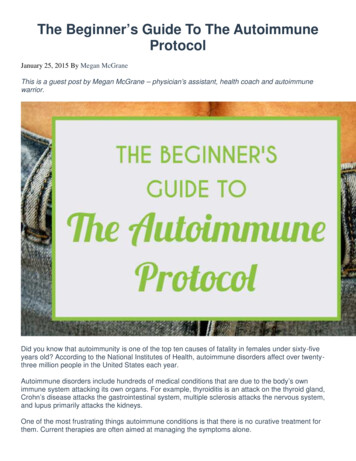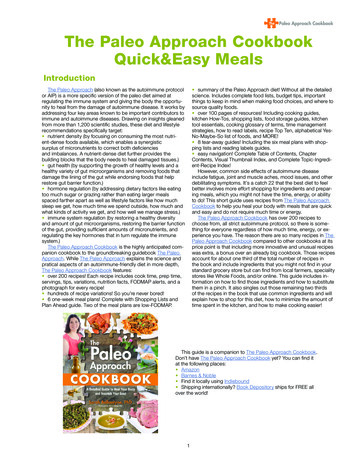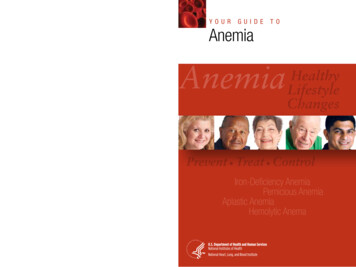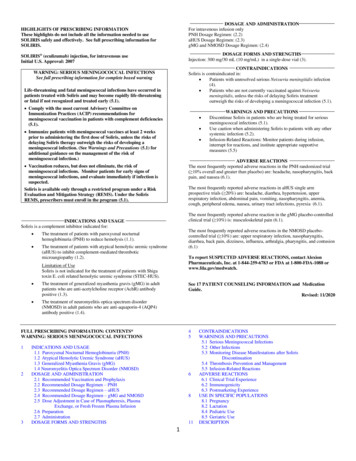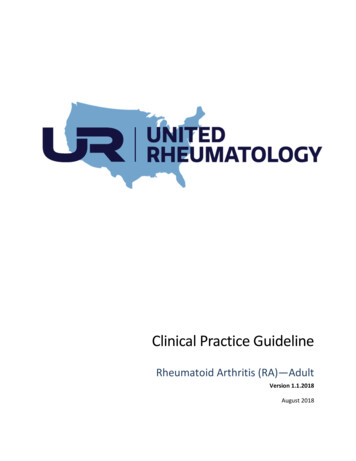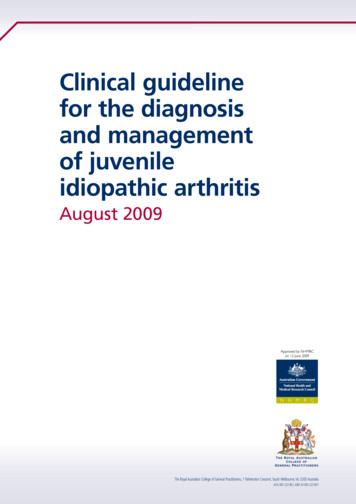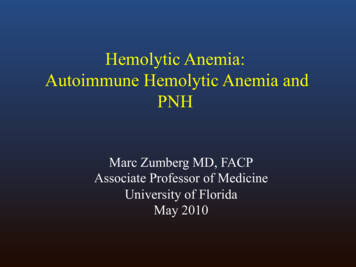
Transcription
Hemolytic Anemia:Autoimmune Hemolytic Anemia andPNHMarc Zumberg MD, FACPAssociate Professor of MedicineUniversity of FloridaMay 2010
Hemolytic Anemia--CausesHereditary RBC MembraneAcquired – Autoimmune– Isoimmune– Drug– HS, HE, pyropoikilocytosis RBC Metabolic Defects– EM pathway– HMP shunt– Nucleotide synthesis Hemoglobin Defects– Thalassemia– Abnormal variantsImmune RBC fragmentation syndromesPNHSecondary– Renal and liver disease Misc– Drugs, infections, chemicals,toxins, physical agents
Laboratory approach to thepatient with suspected hemolyticanemia Laboratory–––––––CBCReticulocyte CountBlood smearLDHBilirubin-direct and indirectHaptoglobinUrinalysis
Laboratory evaluation ofhemolytic anemiaDirectCoombsPositiveNegative
Coombs Warm autoimmune hemolytic anemia Cold agglutinin disease Drug induced Paroxysmal Cold Hemoglobinuria
Coombs HemoglobinopathiesEnzymopathiesMembrane DefectsMicroangiopathicDrugsToxins/Wilson’s diseasePNHEtc .
Autoimmune Hemolytic Anemia(AIHA)-ClassificationWarm-reacting antibodiesCold-reacting antibodies(optimally bind red blood cells at (optimally bind red blood cells37 C 37 C Idiopathic Cold agglutinins Secondary– Idiopathic– Autoimmune disorders– Secondary (associated clinicalconditions)– Immunodeficiencies Infections– Lymphoproliferative disorders Lymphoproliferative disorders– Nonlymphoid malignancies Nonlymphoid malignancies– Viral infections Mixed warm and cold antibodies Drug Induced Paroxsymal cold hemoglobinuria(Donath-Landsteiner antibodies)– Syphilis– Viral infections
Audience Response Question:Coombs testWhich of the following statements about the Coombs test and theblood bank evaluation of autoimmune hemolytic anemia is mostaccurate?A.)A positive Coombs test implies at least low grade hemolysisB.)Cold agglutinins are typically IgG positive on the Coombs testC.)The thermal amplitude of a cold agglutinin is the best predictor of clinicalsignificanceD.)Autoadsorption of autoantibodies are useful to define the specificity of theantibodyE.)The eluate of concentrated IgG from patients with warm autoimmune hemolyticanemia is used to rule out alloantibodies
Direct Coombs test Detects antibody coating the RBC surface Positive test isn’t necessarily diagnostic of hemolysis– As many as 0.1% of healthy blood donors are positive– 1-2% of hospitalized patients are positive Degree of hemolysis doesn’t always correlate with degree ofpositivityReardon. Am J Clin Pathol 2006:125(supl1) S71-S77
Direct Coombs Test30- ‐40%IgGonly10%C3only40- ‐50%mixedIgGC337 C
PatternsIgGC3(67%) (20%) -(13%)- Cold agglutinindisease- Paroxsymal ColdHemoglobinuria- Warm ionMedicine3rdedNY,NY.Churchill- ‐Livingstone.1996.P.49
Elution: Detection of specificity ofthe autoantibody Elute off IgG from patient RBCs– Incubate with reagent RBCs to test for activity andspecificity of the antibody– Antibody most commonly reacts to a full RBCpanel with similar agglutination strengths– Less commonly may show a relative specificitywithin the Rh system such as the e antigen(WAHIA) or I (cold agglutinin)
Difficulty performing a Type andScreen
Autoadsorption: Detection ofAlloantibodies Goal is remove the autoantibody from theserum to allow the detection of alloantibodies– 32% of patients with AIHA have alloantibodies– 1 ml of packed autologous RBCs treated to remove the Aband than incubate with patient’s serum at 37 CReardon AM J Clin Pathol 2006;125(Suppl 1):S71-77
Transfusion in AIHA Proceed with caution-consider risk/benefitratio– Transfused blood often has a short half-life– Use phenotype matched blood if available Rh groups, Kell, Duffy, Kidd antigens If antibody shows specificity for a given antigen useantigen negative blood– If cold agglutinin disease transfuse through a bloodwarmerReardon AM J Clin Pathol 2006;125(Suppl 1):S71-77
Case 1A 63 year-old previously healthy man is admitted with anginaand dyspnea on exertion. He has had a lack of energy for 2 months andhas also complained of some intermittent yellowing of his eyes.No prior blood counts are available. He is taking no medications anddoes not recall any recent illness. He denies alcohol consumption,tobacco, or illicit drug use.Laboratory data and blood smearare as follows:HctMCVWBC countRetic countLDHCoombs26%103 fL5900/ul7.1 %949 IU/LIgG , C3
Warm Autoimmune Hemolytic Anemia(W-AIHA) IgG panagglutinating antibodydirected against “public” epitopeoften on the Rh system– Optimally bind red cells at37 C– Primarily removed by Fcreceptor macrophages in thereticuloendothelial system Partial phagocytosis leadsto spherocytes removedby the spleen– Less commonly or weaklyfixes complementPackman CH. Blood Rev. 2008 Jan;22(1):17-31. PMID: 17904259
spherocytenucleatedRBCPositive Coombs Test
Diagnosis: Warm Autoimmunehemolytic Anemia Investigation– Rule out lymphoproliferative disorder Consider bone marrow aspirate and biopsy– Rule out autoimmune disorder ANA, etc – Rule out immunodeficiency Quantitative immunoglobulins– Rule out drugs
Warm autoimmune hemolyticanemia-Treatment Treat underlying disease if identified Steroids first line (1mg/kg) for one to three weeks– Interfere with ability of macrophages to clear IgG coatedRBC’s– Decreases antibody production– 60-85% initial response (20% CR), but frequent relapses– Initial quick taper, than slowly when down to 20mg (for2-3 months)– Pulses of high dose glucocorticoids may be useful in somewho failKessler. Clin Advances in Hemaotol Onc. 2008; 6(10):739-41King. Semin Hematol. 2005; 42:131-136
Warm autoimmune hemolytic anemiaTreatment Splenectomy– Consider in two-three weeks if no response to steroids– 2/3 respond, but relapses occur– Ensure immunizations and education about infectious risk– Pneumoccus, meningococcus, and hemophilis influenza type B– ? Prophylactic antibiotics– Higher incidence of post-splenectomy venousthrombembolism and pulmonary hypertension High incidence of antiphospholipid antibodiesKessler. Clin Advances in Hemaotol Onc. 2008; 6(10):739-41Crary. Blood. 2009 Oct 1;114(14):2861-8.
Rituximab Chimeric monoclonal antibody targetingCD-20 on mature B CellsMedian time toresponse 6 weeks(2-16)Bussone . AM J Hematol. 2009: 84:153-157
Treatment-Other10% refractory to both steroids and splenectomy Other hamideCyclosporineDanazolIVIG– Not as effective as in ITP Paucity of randomized trials to suggest which agent issuperior Responses may be delayed several monthsKessler. Clin Advances in Hemaotol Onc. 2008; 6(10):739-41
Case 2A 63 year-old previously healthy male complains of fatigue andlack of energy for 2 months. He denies a history of fever, chills, nightsweats or weight loss, but reports painful blue digits in the cold.A routine CBC drawn 1 year ago was normal. Heis taking no new medications and does not recall any recent illness. Hedenies alcohol consumption, tobacco, or illicit drug useLaboratory data and blood smear are as follows:HctMCVWBC countRetic countLDHCoombs26%133 fL5900/ul7.1 %949 IU/LIgG-, C3
Cold agglutinin Disease IgM antibody optimally binds to RBCs atlower temperatures– Fixes complement Direct lysis of red blood cells Removal of C3b-coated RBC’s by the liver– Titers 1:64 usually not clinically significant Titer should increase at lower temperatures– Most commonly with I (or i in infections)Berntsten. Hematology. 2007; 12(5): 361-70specificity
Blood Bank evaluation-ThermalAmplitude Test Keep blood at 37 C from point of bedsidecollection to testing– initial screening is often at 20 C or roomtemperatureReardon. Am J Clin Pathol 2006:125(supl1) S71-S77
Cold Agglutinin Disease:Diagnostic Criteria 1.) Clinical evidence of an acquired hemolytic anemia 2.) Positive Coombs test using anti-C3 3.) Negative Coombs test using anti-IgG 4.) Presence of cold agglutinin with reactivity up to 30 C 5.) Cold agglutinin titer at 4 C 256Petz. Blood Reviews. 2008; 22: 1-15
Cooling of blood during passage through acral parts of the bodyallows cold agglutinins to bind to the RBC leading to agglutination,complement binding, and hemolysisRBCagglutination Spurious marked elevation of MCV, MCHC may occur Agglutination will abate with warmingBerntsten. Hematology. 2007; 12(5): 361-70
Investigation of Cold AgglutininDisease Consider infectious etiologies such asMycoplasma or Epstein-Barr virus Consider lymphoma or other lymphoproliferativedisorders– Serum protein electrophoresis (SPEP)– Bone marrow biopsy if no obvious infection– Consider radiologic imagingBerntsten. Hematology. 2007; 12(5): 361-70
Cold Agglutinin Disease Monoclonal band can be detected in the majority ofpatients on serum protein electrophoresis/immunofixation– Majority IGM κ Kappa 94% in one study– Most encoded by IGHV4-34 gene Clonal B lymphocytes often found by flow even ifbone marrow morphology is negative and no otherevidence of lymphomaBerntsten. Hematology. 2007; 12(5): 361-70
Clinical Moderate chronic hemolytic anemia– Hb usually 9-12 g/dL Most lack physical findings– Acrocyanosis– Raynaud’s phenomenon– GangrenePetz. Blood Reviews. 2008; 22: 1-15
Cold agglutinin DiseaseTreatment Avoid cold environments (temperatures reach 30 inexposed skin vessels)– Wear socks, mittens, ear muffs in cold temperature– Transfuse through a blood warmer when necessary– Caution with bypass surgery or hypothermic surgeries Treat underlying disease– Lymphoma– If secondary to mycoplasma (anti-I), mono (anti-i) or other virustreatment is supportive and hemolysis transient Steroids and splenectomy are not generally effective– Unless secondary to steroid responsive disease lymphomaPetz. Blood Reviews. 2008; 22: 1-15Gertz. Br J Haem. 2007; 138(4): 422-9
Cold agglutinin DiseaseTreatment Cytotoxic therapy– Chlorambucil– Begin with low daily doses of 2-4 mg/day– Follow counts closely– Cyclophosphamide– Favorable responses in the minority of cases– Risk of suppressing bone marrow and reticuloctyeresponsePetz. Blood Reviews. 2008; 22: 1-15Gertz. Br J Haem. 2007; 138(4): 422-9
Cold Agglutinin Disease:Rituximab Gaining popularity with recognition of mostcases of CAD as a clonal B cell disorder Biggest series– 27 patients with 37 courses– OR response rate of 54%, mostly partial– Responders had a median increase in Hb of 4g/dLand decrease in IgM by 54%– Median response time was 1.5 monthsBerensten. Blood. 2004; 103:2925-8
Cold Agglutinin Disease: Plasmaexchange IgM is primarily intravascular Used with life-threateninghemolysis or acrocyanosis– Rapid, but transient responses– Need to use a blood warmer– Consider prior to procedures requiringhypothermiaPetz. Blood Reviews. 2008; 22: 1-15
Audience Response Question:Autoimmune hemolytic anemia treatmentWhich of the following statements is true concerning thetreatment of autoimmune hemolytic anemia?A.)Splenectomy is an effective second line treatment in cold agglutinindiseaseB.)Rituximab has proven effective in trials of cold agglutinin disease, butnot warm autoimmune hemolytic anemiaC.)Steroids usually lead to complete, but transient responses in warmautoimmune hemolytic anemiaD.)Cytotoxic therapy is used more frequently in cold agglutinin disease ascompared to warm autoimmune hemolytic anemia
Treatment comparison between IgG and IgMmediated hemolysisSeverityMechanism ofhemolysisBlood xicPlasmapheresisIgG (WAIHA)IgM (cold aggl.)May be severemoderateFc mediatedComplement mediatedSpherocytesAgglutinationTypically warmcoldYesNoYesYesYesNoRarelyYesNoYes
Case 3A 43 year-old male is referred with a 3 month history oftransfusion dependant anemia. Prior history 1 year ago issignificant for an unprovoked DVT. His only medication iswarfarin. Evaluation has been negative for GI bleeding. Bloodcounts 3 years ago were normalWBC countHbHctPltMCVRetic countLDHHaptoglobinCoombsPeripheralsmear3900/ul9.3 g/dL29%127k/cc mm107 fL5.1 %849 IU/Lundetectablenegativenormal morphology
Case Given Coombs negative, non spherocytic hemolyticanemia, recent DVT, and pancytopenia, PNH issuspected and peripheral blood is sent for CD-55 andCD-59 on RBCsDiagnosis: PNHAcquired clonal hematopoietic stem celldisorder
The glycosyl phosphatidylinositol (GPI) anchorDue to a mutation in thephosphatidylinositol glycancomplementation class A gene(PIGA)Needed to make glycosylphosphatidylinositol (GPI), amolecule that anchors specificproteins to the cell membraneLack of this anchor leads to avariety of clinical sequelaPIG A geneXp22.1Johnson R J , Hillmen P Mol Path 2002;55:145-152 2002 by BMJ Publishing Group Ltd and Association of Clinical Pathologists
Parker. Lancet. 2009 Feb 28;373(9665):759-67
GPI-anchored surface proteins on humanhematopoietic cellsHematology 2008;2008:491-506Copyright 2008 American Society of Hematology. Copyright restrictions may apply.
Overview of the complement cascadeBrodsky, R. A. Blood 2009;113:6522-6527Parker. Lancet. 2009 Feb 28;373(9665):759-67Copyright 2009 American Society of Hematology. Copyright restrictions may apply.
PNH: Selective Survival AdvantageParker. Hematol Oncol Clin North AM 2009; 23(2):333-46
PNH: Clinical Median survival is 10-15 years No current cure other than bone marrowtransplantation 10-15% have spontaneous remissionBessler. Hematology Am Soc Hematol Educ Progam 2008: 104-110
Audience Response Question:Clinical Manifestations Which of the following is not a well describedclinical sequela of PNH A.)Thrombosis of the hepatic vesselsB.)Transfusion dependent anemiaC.)Esophageal spasmD.)PancytopeniaE.)Pulmonary fibrosisF.)Renal dysfunctionG.)Erectile dysfunction
Clinical ManifestationsNature Biotechnology 25, 1256 - 1264 (2007) Published online: 7 November 2007
PNH: Consequences of chronichemolysisBrodsky. Blood Reviews. 2008. 22:65-74
The pathophysiology of disease in patients withparoxysmal nocturnal hemoglobinuria (PNH)Hematology 2008;2008:491-506Copyright 2008 American Society of Hematology. Copyright restrictions may apply.
PNH: Thrombosis Increased propensity for life threateningthrombosis– Cerebral, hepatic, portal, mesenteric, splanchnic,and renal veins– Approximately 40% of patients have a thromboticevent during their illness Higher risk with larger PNH clone ( 60%) Venous greater then arterial Main cause of deathBrodsky. Blood Reviews. 2008. 22:65-74
PNH: Bone Marrow Failure Small to moderate PNH clones found in up to 70% ofpatients with aplastic anemia– Usually less than 30% PNH granulocytes– May evolve into clinical PNH– 20% of MDS patients have small clones Small populations of PNH cells can be found invirtually all healthy controls– Approx 1 in 50,000 granulocytes– Arise from a more differentiated colony forming cell– No self renewal capacityBrodsky. Hematology Am Soc Hematol Educ Program 2008.; 104-110
PNH: Bone Marrow Failure Most patients with clinical manifestations of PNHwho do not have overt signs of marrow aplasia haveevidence of diminished hematopoiesis– Two-thirds exhibit granulocytopenia and/orthrombocytopenia at some time during the course of theirdisease Leukemia develops in up to 5% of patients– The average onset occurs at about five years (range is froma few months to 22 years)Dacie, JV. Proc R Soc Med 1963; 56:587Rosse. Up-To-Date. Clinical manifestations of paroxysmal nocturnal hemoglobinuria. January 2010 last update
PNH: ClassificationsParker. Hematol Oncol Clin North AM 2009; 23(2):333-46
Who should be tested for PNH All patients with unexplained:All patients with unexplained hemoglobinuriaAll patients with unexplained Coombs negativenonspherocytic hemolytic anemiaAll patients with unexplained visceral or cerebralvein thrombosisAll patients with unexplained cytopeniasUnexplained iron deficiencyPNH symptoms—fatigue, esophageal spasms,Unexplained erectile dysfunctionRosse. HemeOnc Today. Feb 10, 2010. 4-5
Audience Response Question:Diagnostic TestingWhich of the following is a true statement regardingdiagnostic testing in PNH?A.)Screening of only red blood cells can lead to falsely negative testsB.)FLAER is the most sensitive reagent to detect PNH on red bloodcellsC.)The percentage of PNH red blood cells more accurately reflects thesize of the clone as compared to white blood cellsD.)CD 55 and CD 4 are the most common GPI anchored proteinantigens evaluated on RBCs of PNH patients
Laboratory TestingBessler. Hematology Am Soc Hematol Educ Program 2008.;Madkaikar. Eur J of Haem. 2009; 83: 503-11
Flow Cytometry on RBCs:Three different phenotypesMadkaikar. Eur J of Haem. 2009; 83: 503-11
Flow Cytometry:RBC vs. WBCMadkaikar. Eur J of Haem. 2009; 83: 503-11
FLAERBrodsky. Blood Reviews. 2008. 22:65-74
PNH:FLAER vs. immunophenotypingMadkaikar. Eur J of Haem. 2009; 83: 503-11
PNH:FLAER vs. immunophenotypingMadkaikar. Eur J of Haem. 2009; 83: 503-11
Historical Management of PNHPalliative options do not impact progression and carry riskfor severe morbidity and mortality Steroids/androgen hormones– No controlled clinical trials Red cell supplements– Folic acid, iron, erythropoiesis-stimulating agents– ESAs may expand clones and elevate hemolysis Transfusions– Transient treatment of anemia– Risk of iron overload Anticoagulants– Prophylaxis is debated, especially if 50% clone– Warfarin is recommended for all with VTE– Maybe ineffective in certain patients1. Hillmen, et al. N Engl J Med. 1995;333:1253-1258.2. Parker, et al. Blood. 2005;106:3699-3709.3. Saso, et al. Brit J Haem. 1999;104:392-396.Alexion slide deckESA erythropoietin stimulating agents
Historical Management of PNHBone Marrow Transplant§ Allogeneic bone marrow transplant– 44% mortality at 2 yrs with HLA-matchedsibling donor– Acute GVHD in 34%; chronic GVHD in 33%– GVHD-free survival in 14% of patients1.2.3.Parker, et al. Blood. 2005;106:3699-3709.Saso, et al. Brit J Haem. 1999;104:392-396.Hegenbart et al. Biology of Blood and Marrow Tplt. 2003;9:689-697Alexion slide deck
Audience Response Testing:EcluzimabWhich of the following is the most likelyconsequence in a PNH patient treated withEcluzimab?A.)Increase in hemoglobin to normalB.) Neisseria meningitides infectionC.)Increase in the percentage of Type III (totally deficient of GPIlinked proteins) erythrocytesD.)Deep vein thrombosisE.)Stabilization of LDH
Structure of eculizumabBrodsky, R. A. Blood 2009;113:6522-6527Hillmen, P. Hematology 2008;2008:116-123Copyright 2009 American Society of Hematology. Copyright restrictions may apply.
Ecluzimab PNH Clinical StudiesPilot Study – NEJM. 2004N 11TRIUMPH – NEJM. 2006Pivotal Phase III, Double-Blind, PlaceboControlled Trial, N 87Long-Term Extension TrialHillmen Blood. 2007Evaluated long-term safety, efficacyand effect on thrombosis; Placebopatients switched to SOLIRIS N 187SHEPHERD – Blood. 2008Broader patient population, including thosereceiving minimal transfusions or withthrombocytopenia, N 97Modified Alexion slide deck
Kaplan-Meier Curves for the Time to the First Transfusionduring TreatmentHillmen P et al. N Engl J Med 2006;355:1233-1243
Stabilization of Hemoglobin Levels and the Number of Unitsof Packed Red Cells Transfused during TreatmentHillmen P et al. N Engl J Med 2006;355:1233-1243
Mean (SE) units packed red blood cells transfused by pretreatment transfusion strata during the TRIUMPH andSHEPHERD studiesHillmen, P. Hematology 2008;2008:116-123Copyright 2008 American Society of Hematology. Copyright restrictions may apply.
Levels of lactate dehydrogenase duringtreatment with EculizumabHillmen, P. Hematology 2008;2008:116-123Parker. Lancet. 2009 Feb 28;373(9665):759-67
PNH RBC proportions (mean { /-} SE) duringEculizumab treatmentBrodsky, R. A. et al. Blood 2008;111:1840-1847Copyright 2008 American Society of Hematology. Copyright restrictions may apply.
Analysis of thrombosis before and duringEculizumab therapyHillmen, P. Hematology 2008;2008:116-123Copyright 2008 American Society of Hematology. Copyright restrictions may apply.
Ecluzimab: Expectations of therapyParker. Hematol Oncol Clin North AM 2009; 23(2):333-46
Safety In three major trials no patients withdrew dueto an adverse event– 2/195 patients developed meningococcal sepsis Vaccinations required Alert cards suggested– Nasopharyngitis– Headache– Upper respirator tract infections
Future therapy? Inhibitor of complement C9– Block MAC and control hemolysis– Leave intact downstream functions of complementincluding the ability to generate C5a Reduce risk of Neisseria sp infectionsParker. Lancet. 2009; 373:759-67
blood bank evaluation of autoimmune hemolytic anemia is most accurate? A.)A positive Coombs test implies at least low grade hemolysis B.)Cold agglutinins are typically IgG positive on the Coombs test C.)The
